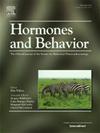运动和短暂性雌二醇暴露对中年雌性大鼠的影响。
IF 2.4
3区 医学
Q2 BEHAVIORAL SCIENCES
引用次数: 0
摘要
雌激素治疗对中老年妇女认知的益处取决于许多因素,包括治疗的时机。此外,它与其他生活方式因素(如锻炼)的潜在相互影响尚不清楚。在这项研究中,我们使用绝经大鼠模型,测试了中年开始的雌激素和自愿运动的独立和联合治疗的持久益处。12个月大的退休雌性育种犬切除了双侧卵巢,并通过皮下植入接受了为期6周的17β-雌二醇(E2)治疗,有或没有使用跑步轮。E2治疗后,运动组的动物可以多跑七周,包括两周的认知和情感测试。随后,评估海马神经元和细胞的可塑性。E2和运动分别对行为和细胞结果测量产生影响。短暂的E2治疗持久地增加了运动输出,降低了体重,增加了行为可塑性。运动减少海马小胶质细胞总数,增加脑重量。没有观察到运动和E2治疗的叠加效应。E2治疗可能提供了一种持续增加中年身体活动的方法,但E2和运动结合并不会对海马行为或细胞可塑性产生额外的好处。本文章由计算机程序翻译,如有差异,请以英文原文为准。
Effects of exercise and transient estradiol exposure in middle-aged female rats
The benefits of estrogen treatment on cognition in middle-aged and older women are dependent on many factors, including the timing of treatment. Moreover, the potential interactive effects with other lifestyle factors, such as exercise, are poorly understood. In this study, we tested for lasting benefits of independent and combined treatment with estrogen and voluntary exercise initiated in midlife, using a rat model of menopause. Twelve-month-old, retired female breeders were bilaterally ovariectomized and received six weeks of 17β-estradiol (E2) treatment via subcutaneous implant, with or without access to running wheels. After E2 treatment, animals in the exercise groups had running wheel access for seven additional weeks, including a two-week period of cognitive and affective testing. Thereafter, hippocampal neuronal and cellular plasticity were assessed. E2 and exercise independently exerted effects on behavioral and cellular outcome measures. Transient E2 treatment enduringly increased motor output, lowered body weight, and increased behavioral plasticity. Exercise decreased total hippocampal microglia number and increased brain weight. No additive effects of exercise and E2 treatment were observed. E2 treatment may provide a means by which to enduringly increase physical activity in middle age, but combined E2 and exercise do not produce additive benefits on hippocampal behavioral or cellular plasticity.
求助全文
通过发布文献求助,成功后即可免费获取论文全文。
去求助
来源期刊

Hormones and Behavior
医学-行为科学
CiteScore
6.70
自引率
8.60%
发文量
139
审稿时长
91 days
期刊介绍:
Hormones and Behavior publishes original research articles, reviews and special issues concerning hormone-brain-behavior relationships, broadly defined. The journal''s scope ranges from laboratory and field studies concerning neuroendocrine as well as endocrine mechanisms controlling the development or adult expression of behavior to studies concerning the environmental control and evolutionary significance of hormone-behavior relationships. The journal welcomes studies conducted on species ranging from invertebrates to mammals, including humans.
 求助内容:
求助内容: 应助结果提醒方式:
应助结果提醒方式:


